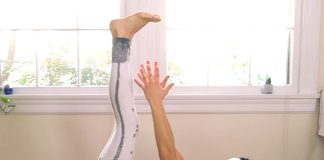Flow yoga can be quite athletic as it gives you a slight cardiac workout while allowing the poses to flow together. While this style is great for energetic yogis it may not be for everyone. It may also be beneficial to try a slower yoga before going to a dynamic yoga class so you can get a handle on the poses.
What is Gentle Flow Yoga?
Gentle flow or gentle yoga is a softer approach to Dynamic yoga. While the poses still flow together, the nature of it is much slower in pace and gentle in practice. It is the in between of keeping active while still maintaining that peaceful and enjoyable approach. There is less strain for mind and body.
Who Can Do Gentle Flow Yoga?
Anyone and everyone. At one point it was mainly pregnant women or those recovering from illnesses who used it the most but over the years, many more yogis choose this style because it is more gentle. From beginners to experts, everyone can benefit from this style of yoga. Experienced yogis will already be familiar with the poses and stretches but that doesn’t stop beginners stepping in and trying it as well.
What Are The Benefits Of This Type Of Yoga?
Designed for a slower pace.
This means it is available to many yogis who may struggle to do other forms of yoga. Whether they have limited capabilities, limited strength or flexibility, it can be adapted to suit everyone’s needs. It proves a point that you actually don’t have to but fully fit and able to try yoga. Stereotypically we imagine these young fit people in sports wear but actually yoga can accommodate all types of people, forget the stereotypes!
Relaxing.
The gentle pace will still allow you enjoy the poses and relax your mind and body. This will set you up for the rest of the day and give you a positive outlook.
De-stressing.
Although the pace is slower you will still enjoy the transitions and flow from pose to pose. Helping you forget about your worries and ground yourself. You can literally feel the stress melting away and your muscles relaxing, free from anxiety.
Get back in touch with your body.
Every day we abuse our bodies whether it is going to work or the pressure of family life. Often we leave so little time for ourselves.
Stretches.
Helps you stretch your muscles and develop your body. This will improve your muscle tone and increase flexibility. As the poses and flow is slow you can hold the poses for as long as 5 minutes or maybe more if you are doing it alone.
Increase flexibility.
Just like other forms of yoga it will still allow you to improve your flexibility. Holding poses and stretching your muscles will contribute to overall flexibility, over time you will see improvements.
Good environment.
Classes are relaxed, happy and calm. Yoga classes in general are relaxed and calm but in a slower paced approach you will feel the difference in the environment around you. Everybody is there to relax and you will feel that emanating from each other.
Compliments other exercises.
You might be going to the gym, an avid cross trainer user or runner. Whatever the exercise, it will be more boisterous and strenuous – on purpose of course. On your rest days, instead of doing nothing you may prefer to aid your recovery with some gentle, no strain yoga. Allowing you to be active without the intensity of a hard work out but still keeping your body moving.
Can still aid weight loss.
Although the style is slower, it will still be fairly active and give your body a workout. Possibly due to the lack in production of cortisol (studies have concluded it is because of this reason the body reacts different and manages it’s fuel differently).
It can be done at home.
Just like other yogas, you aren’t limited to going to a class and can do it at home. Once you know the poses and the general flow of the approach you can start enjoying it at home in between classes or as a break from them. Whatever you prefer.
Allows you to be ‘free’.
As the poses flow together there is less emphasis on them being properly correct, you can go from one pose to another without worry about polishing it.
Alignment.
It will help you correct your alignment and work on your posture
Restorative & injury.
This gentle approach is good as a restorative form and means anyone recovering from injury can possibly try this approach. They would be advised to seek advise before hand and possibly be guided by a physiotherapist.
Support.
Going to the classes provides a great support group and helps your emotional well being.
47 Most Famous Motivational Quotes of All-Time
49 Greatest Love Quotes
37 Inspirational Quotes that Will Change Your Life






























